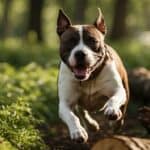Vitamin E plays a crucial role in maintaining your dog’s health, acting as a powerful antioxidant that protects their body from oxidative damage.
This essential vitamin is key not only for supporting their immune system but also for promoting healthy skin and coat.
When you provide your furry friend with a raw diet, it’s important to ensure they’re getting enough vitamin E to prevent deficiencies that can lead to health issues.

Natural sources of vitamin E are readily available and can easily be incorporated into your dog’s raw diet.
Foods such as leafy green vegetables, eggs, and some oils are packed with this nutrient, promoting optimal canine health.
By understanding the benefits of vitamin E and how to include it in your dog’s diet, you can help your pet thrive.
Given the significance of vitamin E, you might be wondering about the safest ways to include it in your dog’s raw diet and the signs of vitamin E deficiency to watch for.
It’s important to balance the intake of this vitamin, as both deficiency and excess can have adverse effects.
Integrating the right amount of vitamin E is essential for a balanced diet, ensuring your dog receives the full spectrum of benefits from their meals.
Understanding Vitamin E for Dogs

Vitamin E plays a crucial role in your dog’s health, functioning as a fat-soluble antioxidant that supports various bodily systems.
Here’s what you need to know to ensure your furry friend is getting enough of this essential nutrient.
Benefits of Vitamin E
Vitamin E, comprising tocotrienols and tocopherols, is an antioxidant vital for protecting your dog’s cells from the damage caused by free radicals.
Regular intake of this nutrient supports the immune system, promotes skin health, and is essential for the proper functioning of the reproductive system.
Additionally, Vitamin E can contribute to cardiovascular health and may help manage conditions like arthritis and atopic dermatitis in dogs.
Identifying Vitamin E Deficiency
Spotting a vitamin E deficiency in your dog can be challenging, but there are signs you can look out for.
Symptoms might include dullness or weakness of the coat and skin, reproductive issues, or a predisposition to infections due to a weakened immune response.
If you notice any of these signs or if your dog is experiencing stiff joints which could be indicative of arthritis, it might be time to evaluate their diet for adequate Vitamin E levels or consult a veterinarian.
Vitamin E in a Dog’s Diet

Vitamin E is essential for your dog’s health, functioning as a powerful antioxidant to help protect their cells.
It also supports a healthy immune system and skin.
Getting enough of this vital nutrient is just as important for your dog as it is for you.
Natural Sources of Vitamin E
Your dog can obtain Vitamin E from a variety of natural sources in their diet.
Here’s a breakdown of some foods rich in Vitamin E that you might include in a raw diet plan:
- Fish: Particularly rich sources like salmon, known for its antioxidant properties, contribute to healthy skin and coat.
- Green Vegetables: Leafy greens such as spinach and turnip greens are great options for including Vitamin E in your dog’s diet.
- Seeds and Oils: A spoonful of fish oil as a supplement can boost Vitamin E intake.
- Colorful Veggies: Vegetables like butternut squash and sweet potato provide a hearty dose of Vitamin E along with other beneficial nutrients.
- Fruits: Blueberries are not only loaded with antioxidants but also a tasty source of Vitamin E for your furry friend.
- Liver: Loaded with nutrients, beef liver is another beneficial addition that supports Vitamin E levels.
Including these foods in your dog’s raw diet can help maintain a healthy balance and prevent deficiency.
Always consult your veterinarian about the appropriate portions and dietary balance for your individual dog’s needs.
Commercial Dog Food vs. Raw Diet

When choosing how to feed your dog, it’s important to consider how different diets contribute to your pet’s vitamin E intake.
Vitamin E is an essential nutrient for dogs, and both commercial dog food and raw diets offer varying levels of this important antioxidant.
Role of Commercial Food in Providing Vitamin E
Commercial dog food is often fortified with vitamins and minerals to meet the nutritional standards established by the AAFCO (Association of American Feed Control Officials).
This means that a high-quality commercial dog food will typically contain a standardized amount of natural Vitamin E required for your dog’s health.
Manufacturers may add Vitamin E sources like chicken, beef, pork, or lamb to their formulations, and some may even include kelp as a natural source of this vital nutrient.
When you feed your dog a commercial food that complies with AAFCO guidelines, you can be assured that the food is designed to prevent a vitamin E deficiency.
Benefits of a Raw Diet for Vitamin E Intake
Switching to a raw diet can often mean your carnivorous companion is getting Vitamin E directly from fresh, whole food sources.
Natural Vitamin E is found in the fats of meats like pork, beef, and lamb—which are staples in a raw feeding plan.
Additionally, a raw diet may include organ meats and muscle meats which are filled with various nutrients.
By incorporating these items, your dog can enjoy a diet that is closer to what they might eat in the wild.
However, it’s crucial to ensure the raw diet is balanced, and to consider supplementing with other Vitamin E-rich foods like kelp to maintain optimal health.
Supplementation of Vitamin E

Vitamin E is an essential nutrient for your dog, with supplementation sometimes necessary to prevent deficiencies, especially in dogs on a raw diet.
It’s crucial to follow safe practices in supplementing vitamin E to maintain your dog’s health without causing harm.
Safe Supplementation Practices
To safely supplement vitamin E for your dog, it’s important to understand the correct dosage.
The appropriate amount often depends on your dog’s size, diet, and health condition.
A common recommendation is to start with a low dosage, around 100-400 International Units (IU) for small dogs and 400-800 IU for larger breeds.
Always consult with your veterinarian to determine the right dosage for your pet.
When introducing vitamin E supplements to your dog’s diet, use nutraceuticals designed specifically for canine needs and ensure the administration follows the product guidelines.
Incorporate the supplement into your dog’s regular meals to help with absorption.
Here’s a simple way to remember how to administer vitamin E:
- Start with low dosage: Begin with the smallest recommended dose.
- Consult your vet: Ensure the amount is suitable for your dog’s specific needs.
- Follow the label: Use pet-specific supplements and adhere to the instructions.
Minimizing Risks of Vitamin E Supplementation
While vitamin E is generally safe, there is a risk of overdose or toxicity if administered in large amounts.
Signs of vitamin E overdose may include lethargy, diarrhea, or vomiting.
To minimize these risks, stick to the recommended dosage and be vigilant for any adverse side effects.
If you observe any unusual symptoms in your dog after starting vitamin E supplementation, contact your veterinarian immediately.
Remember:
- Adhere to recommended dosages: Avoid the temptation to exceed suggested levels.
- Monitor your dog: Watch for any changes in your pet’s health or behavior.
- Keep records: Track the amounts and frequency of supplementation for future reference.
By following these guidelines, you can safely include vitamin E supplementation in your dog’s diet, helping to support their overall health and well-being.
Keep in mind that supplements are not a substitute for a balanced diet and should be used in conjunction with a nutritionally complete feeding plan.
Integrating Vitamin E into Your Dog’s Holistic Health Plan

Vitamin E is a powerful antioxidant that plays a crucial role in supporting your dog’s overall well-being.
Including it in your dog’s diet not only promotes heart health but also aids in maintaining good vision.
To ensure you’re meeting your furry friend’s health needs, here are some friendly tips on incorporating Vitamin E into their holistic health plan:
Dietary Sources
Consider these natural sources:
- Leafy greens: Spinach and kale
- Plant oils: Wheat germ oil and safflower oil
Supplementation
If your dog’s diet isn’t rich in Vitamin E, you might look into supplements. Essential for dogs, especially for:
- Fertility support: Vitamin E can help if you’re breeding your dog.
- Liver function: Protects the liver from oxidative damage.
- Skin care: Helps alleviate dry, itchy skin.
Dosage
Follow these guidelines:
- Consult your vet for an optimal dosage
- Monitor your dog’s response to the supplement
Healing and Repair
Vitamin E is known for its healing properties that can help mend your dog’s wounds.
Apply Vitamin E oil gently on the affected area to enhance the healing process.
Remember, balance is vital. Too much of anything, including Vitamin E, could lead to health issues.
So, it’s important to tailor your dog’s diet for balanced and optimal health.
Keep an eye out for any changes and consult your vet regularly to ensure your dog’s health plan is as perfect as their wagging tail.















